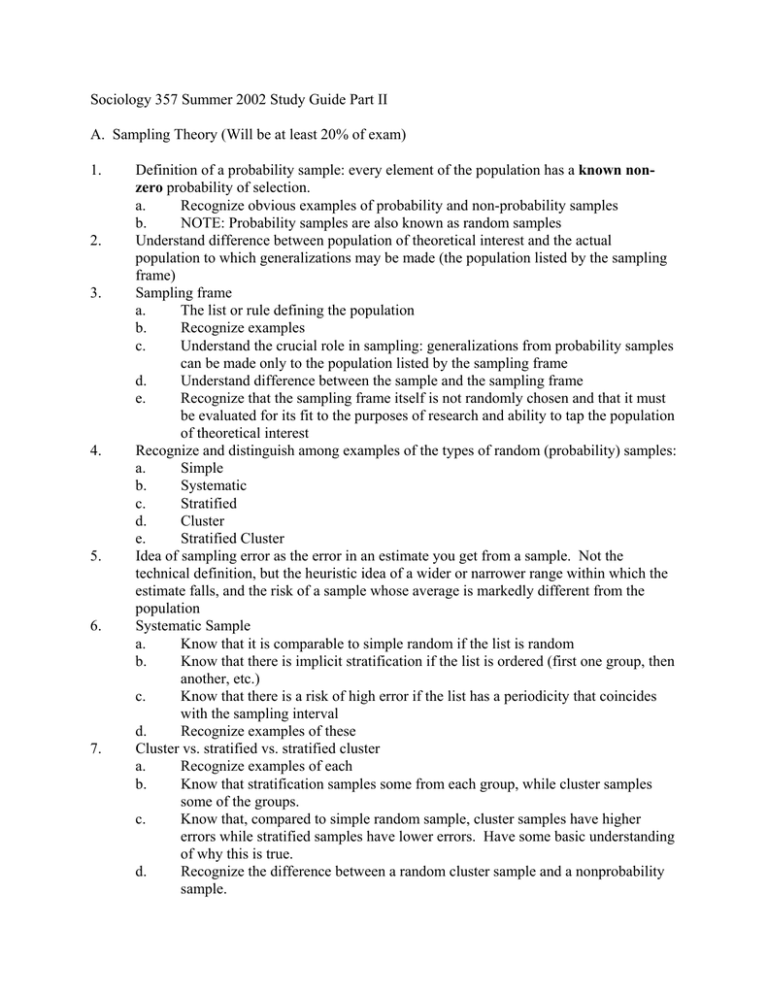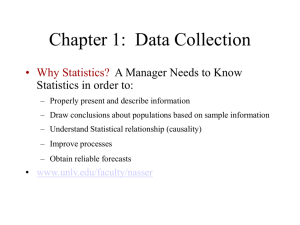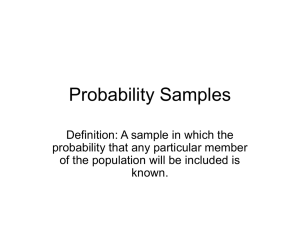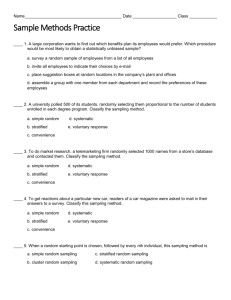Sociology 357 Summer 2002 Study Guide Part II 1. known non-
advertisement

Sociology 357 Summer 2002 Study Guide Part II A. Sampling Theory (Will be at least 20% of exam) 1. 2. 3. 4. 5. 6. 7. Definition of a probability sample: every element of the population has a known nonzero probability of selection. a. Recognize obvious examples of probability and non-probability samples b. NOTE: Probability samples are also known as random samples Understand difference between population of theoretical interest and the actual population to which generalizations may be made (the population listed by the sampling frame) Sampling frame a. The list or rule defining the population b. Recognize examples c. Understand the crucial role in sampling: generalizations from probability samples can be made only to the population listed by the sampling frame d. Understand difference between the sample and the sampling frame e. Recognize that the sampling frame itself is not randomly chosen and that it must be evaluated for its fit to the purposes of research and ability to tap the population of theoretical interest Recognize and distinguish among examples of the types of random (probability) samples: a. Simple b. Systematic c. Stratified d. Cluster e. Stratified Cluster Idea of sampling error as the error in an estimate you get from a sample. Not the technical definition, but the heuristic idea of a wider or narrower range within which the estimate falls, and the risk of a sample whose average is markedly different from the population Systematic Sample a. Know that it is comparable to simple random if the list is random b. Know that there is implicit stratification if the list is ordered (first one group, then another, etc.) c. Know that there is a risk of high error if the list has a periodicity that coincides with the sampling interval d. Recognize examples of these Cluster vs. stratified vs. stratified cluster a. Recognize examples of each b. Know that stratification samples some from each group, while cluster samples some of the groups. c. Know that, compared to simple random sample, cluster samples have higher errors while stratified samples have lower errors. Have some basic understanding of why this is true. d. Recognize the difference between a random cluster sample and a nonprobability sample. e. 8. 9. 10. 11. 12. Know that stratification is worthwhile when the groups are different from each other, and it is not too costly to perform the stratification. f. Know that cluster sampling is worthwhile when the clusters are comparable to each other and there are substantial cost savings from clustering, so that a larger sample is possible g. Recognize examples of reasonable and unreasonable stratification or clustering. h. Understand the idea of creating strata of clusters, and then sampling clusters from each stratum of clusters. i. Recognize examples of stratified cluster sampling, and distinguish it from other types of samples. j. Complex multistage probability samples often involve several nested steps of stratified cluster sampling. Response rates and non-response bias a. Need for call-backs to bring up response rate b. Samples without call-backs may be, in practice, indistinguishable from controlled quota samples. Convenience vs purposive sampling a. Neither is probability sample b. Convenience is pure convenience, not related to purposes of research Justifications for purposive sampling: a. Small samples <30, too small for random sampling to be adequate: choose subjects appropriately for purposes of research b. Hard-to-get populations that cannot be found through screening general population Quota sampling a. Recognize examples when described b. Recognize this is essentially convenience sampling c. Controlled quota samples use probability sampling down to the last level, then quota. Factors affecting needed sample size: Paired examples may ask you which one would need larger sample size, or you may be asked to pick these out of a list including other (irrelevant) factors a. Recognize that accuracy of sample depends upon sample size, not ratio of sample to population b. Heterogeneity: need larger sample to study more diverse population c. Desired precision: need larger sample to get smaller error d. Sampling design: smaller if stratified, larger if cluster e. Nature of analysis: complex multivariate statistics need larger samples B. Other 13. Understand the idea that different measures of the same concept will be correlated with (have bivariate association with) each other. 14. Possibly have simple examples of reliability analysis and discuss what they imply about the measurement of the concept. 15. General idea of statistical control for extraneous variables in isolating cause-effect relations









